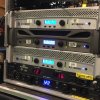- Joined
- Feb 5, 2019
- Messages
- 3,688
- Likes
- 4,069
Another factor in the desire for very low noise levels is the way it is measured and referenced on the datasheet. For a power amplifier, it is typically referenced to full-scale output, thus distortion normally falls as the signal level drops, but the noise floor is relatively constant. That means if the SINAD is dominated by noise, typical at low output, then if you are listening at 50 dB below the max output you are getting much closer to the noise floor. My system can put out around 105 dB or so from a pair of speakers but I usually listen around 65~70 dB (though often louder for music). So if the amp only has 80 dB SNR (or SINAD limited by noise) relative to maximum (full-scale) output the noise floor is only about 50 dB down.
Thanks for the long post. I don't get this part though.
How do you know that "the noise floor is only about 50 dB down"? Calculus or measurement?

